

Switchback Travel


Switchback Travel
Price: $499
Weight: 2 lbs. 0.2 oz.
Fill: 19.7 oz. of 850-fill down
What we like: Warm, comfortable, and stylish for a sleeping bag.
What we don’t: You can get similar warmth for less weight and money.
See the Patagonia 850 Down Sleeping Bag
We’ve never seen a sleeping bag release get as much hoopla as Patagonia’s 850, but that just goes to show how big the brand is in the outdoor world. The company has two models in the lineup: 19°F and 30°F bags, and both are filled with generous amounts of 850-fill goose down. We took the warmer version out for some early spring backpacking in Southern Utah and this much is clear: it’s a premium bag and the design and build live up to Patagonia standards. Below we break down the Patagonia 850 Down Sleeping Bag’s weight, warmth and insulation, features, durability, and more. To see how the Patagonia 850 stacks up, see our article on the best backpacking sleeping bags.
Weight is a top consideration for many backpackers, so we will get right to the point. In a size regular, the Patagonia 850 Down Sleeping Bag 19°F weighs 2 pounds 0.2 ounces, which is competitive with other premium lightweight bags. For comparison, the Patagonia weighs around 3.5 ounces more than the Feathered Friends Swallow YF 20 and 3.2 ounces more than the Western Mountaineering UltraLite—two of our favorite backpacking models. However, the Patagonia bag has more down fill at 19.7 ounces than either of those bags and a more substantial hood (more on that below), which contribute to the extra ounces. You can save weight with the 30-degree version of the Patagonia 850 Down (1 pound 9.9 ounces), but that bag is more summer-specific, and the 19-degree model definitely is the more versatile of the two.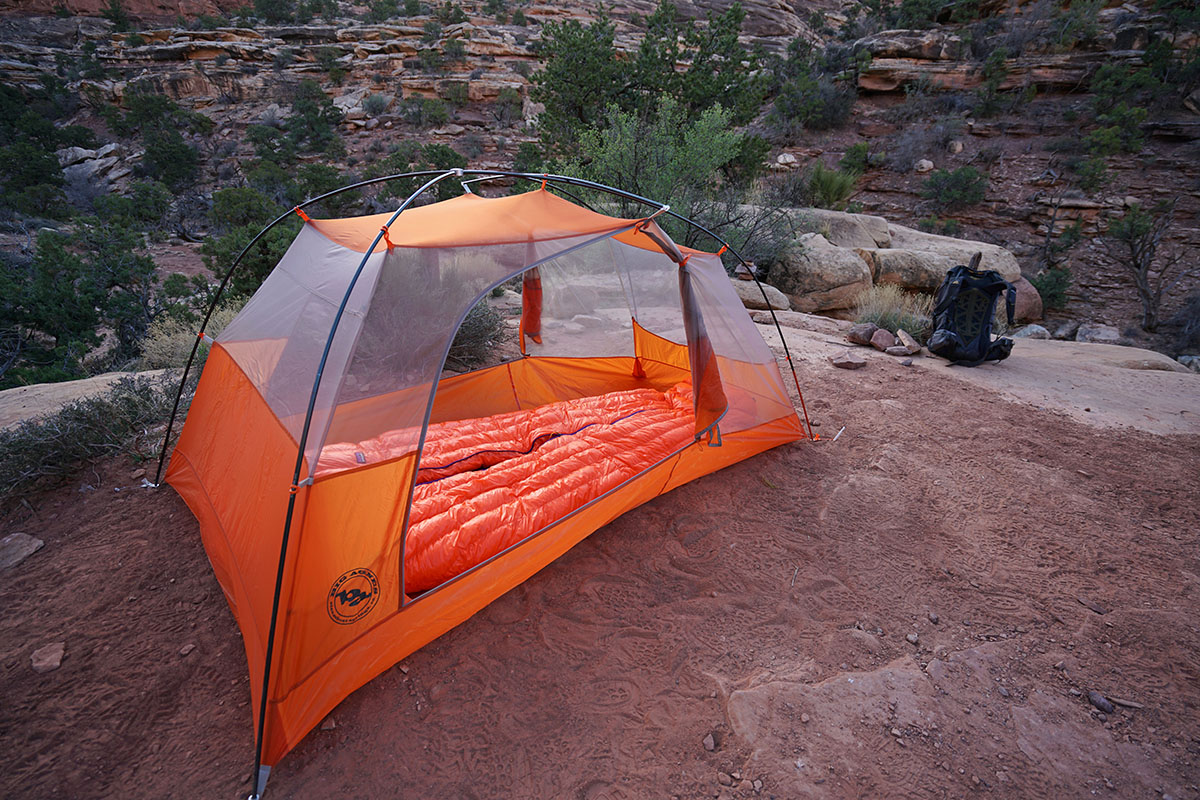
The Patagonia 850 Down Sleeping Bag has an EN Lower Limit of 19°F, which is an ideal 3-season rating in our opinion. We always recommend allowing a buffer of about 10 degrees above the actual temperature rating, meaning that the Patagonia 850 should be very comfortable down to right around freezing or a little below. In a pinch or with strategic layering, you should be fine down to the actual rating of 19°F. For most 3-season backpacking trips, this is ample warmth. If you know it’s going to be hot or have multiple bags in your gear closet, the 30-degree version is lighter and can do the trick. We tested the Patagonia 850 in the canyons of southern Utah in early March when the average lows at night were around freezing. However, our trip was unseasonably warm, and as we expected, the Patagonia kept us very comfortable with no noticeable cold spots.
When talking about warmth, it’s always important to look at a bag’s fill power and fill weight. Fill power is the measure of how much loft or fluffiness down clusters have, while weight is how much actual down is stuffed inside the bag. In this case, the Patagonia 850 has 19.7 ounces of 850-fill goose down, which is very competitive with heavy hitters from Feathered Friends and Western Mountaineering. For example, the Feathered Friends Swallow Nano YF 20 has 16.8 ounces of 900-fill down, and the Western Mountaineering UltraLite has 16 ounces of 850-fill down. In the end, all three are very impressive in terms of warmth for the weight (anything above 800-fill falls on the premium end of the spectrum). It’s worth mentioning that Feathered Friends and Western Mountaineering bags aren’t EN- or ISO-rated, but we’ve found them to be on the conservative side.
In terms of comfort, the Patagonia bag hits the mark. The interior liner is soft and cozy to sleep in, the 850-fill down has high loft, and the hood is large and warm. One thing to consider is that the 15-denier shell fabric is decently thin, meaning that it is slightly more crinkly or crunchy than higher-denier sleeping bags that generally are a bit smoother in feel. This didn’t bother us and ounce-counters are used to the feel of ultralight gear, but those used to thicker models may notice the difference.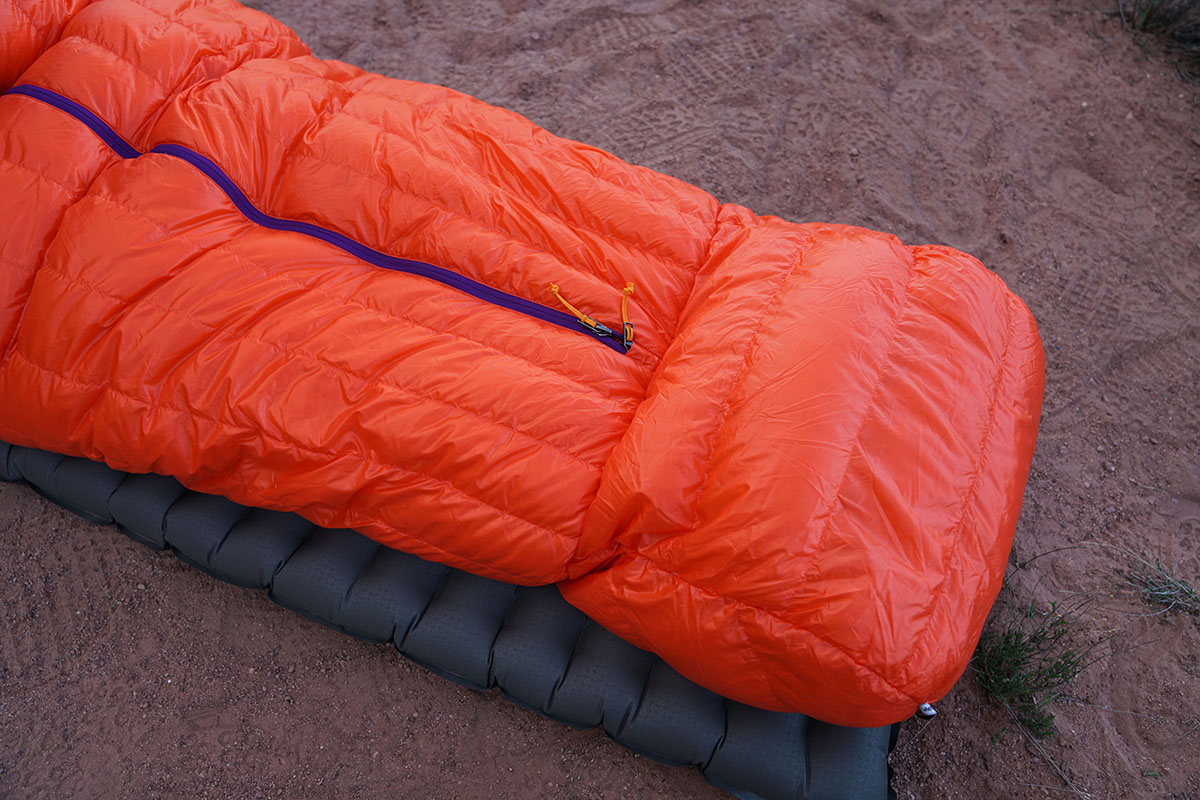
Right off the bat, one of the distinguishing features of the Patagonia 850 Down Sleeping Bag is the center zipper. The vast majority of sleeping bags have a side zipper on the right or left, but Patagonia went straight down the middle. The zipper runs the length of the bag down to the footbox and has three sliders, giving you a good deal of freedom to open up the bag in the middle while keeping it closed toward the head and feet.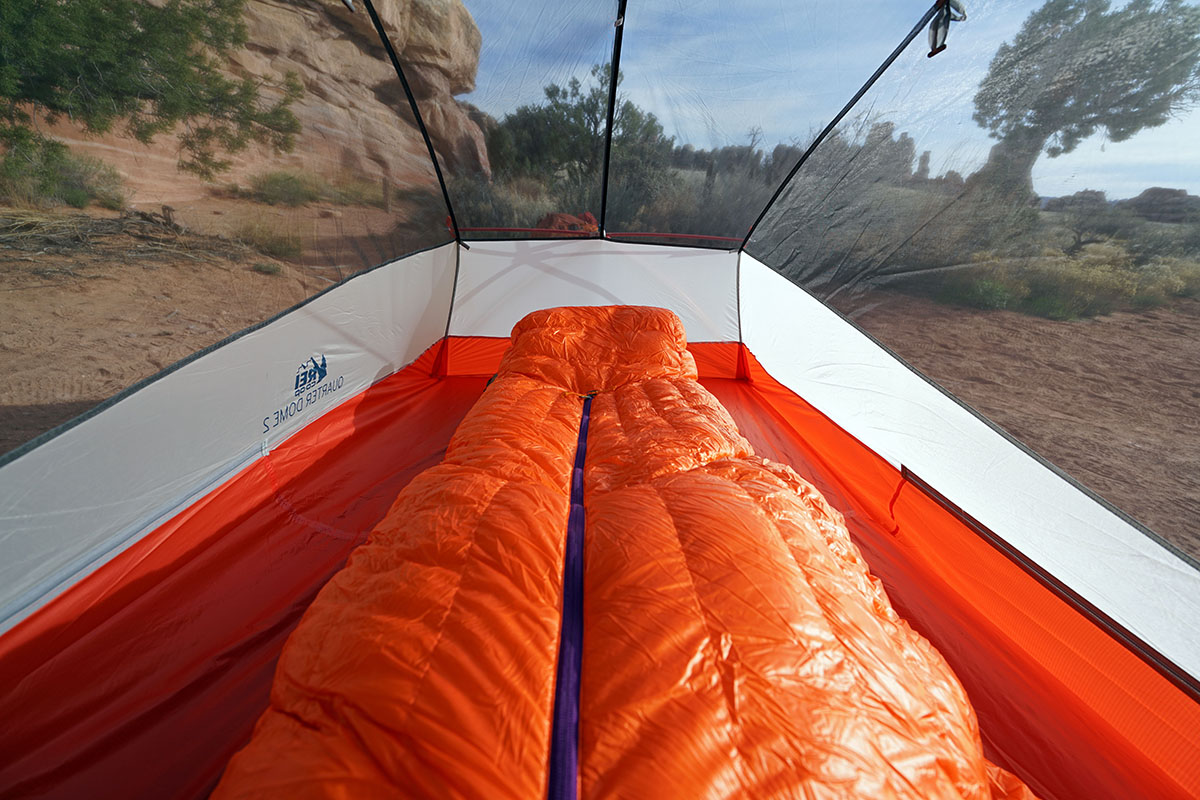
In practice, we found that the center zipper didn’t offer the tangible benefits we had hoped for. During a warm night in Utah that stayed solidly in the 40s, we unzipped the bag around the neck but found that it fell away leaving our torso exposed. After waking up cold, we then tried keeping it zipped at the head end the bag while leaving a large portion in the middle unzipped. This system did vent some heat, but when sleeping it’s difficult to keep the unzipped portion open wide. When using bags with the side zippers partially unzipped, the result is virtually the same. To us, the center zip wasn’t necessarily better or worse, just different.
If there is any one area where the Patagonia 850 Down Bag stands out, it’s the hood. It’s downright plush, offering complete head coverage that kept us warm and protected throughout the night. To hone in the fit, you get two simple drawcords that allow for tightening around the face (we could tighten it down so far that the opening had little more than our mouth and/or nose exposed). The size and warmth of the hood is a notable upside compared to most bags from Feathered Friends and Western Mountaineering, which are full mummies but don’t offer as much head protection or warmth as the Patagonia.
We bought the Patagonia 850 Down Sleeping Bag just a few days after it was released and likely got the first run. New gear often has some kinks that get worked out over future generations, and we experienced one here with the stuff sack, which has two separate drawcord cinches at the top. When cinched tight, the closure for the outer drawcord wouldn’t stay in place and the top of the stuff sack expanded outward. The bag stayed entirely inside the sack (the main cinch closure worked fine) and we weren’t cramped for space on this trip, but this was not something that we expected from a $500 sleeping bag. The bag has seen a couple of updates since its release, but unfortunately the cinches are still known to slide open slightly when stuffed.
The Patagonia 850 Down Sleeping Bag has a 15-denier Pertex Quantum shell, which is thinner than the 20-denier shell on the Feathered Friends Swallow YF 20 and slightly more substantial than the 12-denier on the Western Mountaineering UltraLite. This is fairly standard for a lightweight design, and we’ve used these products from Patagonia and other companies without many issues. However, you will want to take reasonable precautions such as keeping it away from sharp objects and fire (small flying embers can be a gear killer). It’s also a good idea to pack the sleeping bag safely on this inside of your pack instead of exposed on the outside. And the 15-denier shell is not ideal if you plan on bringing your dog along on your adventures (ours often sleeps at the foot of our bag). 
We tested the 19-degree version of the 850 Down Sleeping Bag, and Patagonia also makes it in a 30-degree model. The latter costs $100 less at $399, shaves off 6.3 ounces, and the zipper is only half-length compared to the full-length center zip on the version we tested. For most mild summer adventures, the 30-degree bag should suffice. However, for 3-season backpacking and especially at higher elevations, we prefer the versatility and added buffer of the 19-degree bag. Finally, we like that both options are made in short, regular, and long versions.
As we’ve come to expect from Patagonia, the 850 Down Sleeping Bag embodies the brand’s focus on sustainability and ethically sourcing its materials. First, the down is certified to the Advanced Global Traceable Down Standard, which means that it was traced from the farm to the factory to ensure that birds were not force-fed or live-plucked. Second, the bag’s fabrics are bluesign-approved, which indicates that Patagonia took extra measures during production to reduce negative effects on the environment, workers, and consumers. In the end, we appreciate the added transparency, and this is just another way in which Patagonia sets itself apart in a very competitive market. 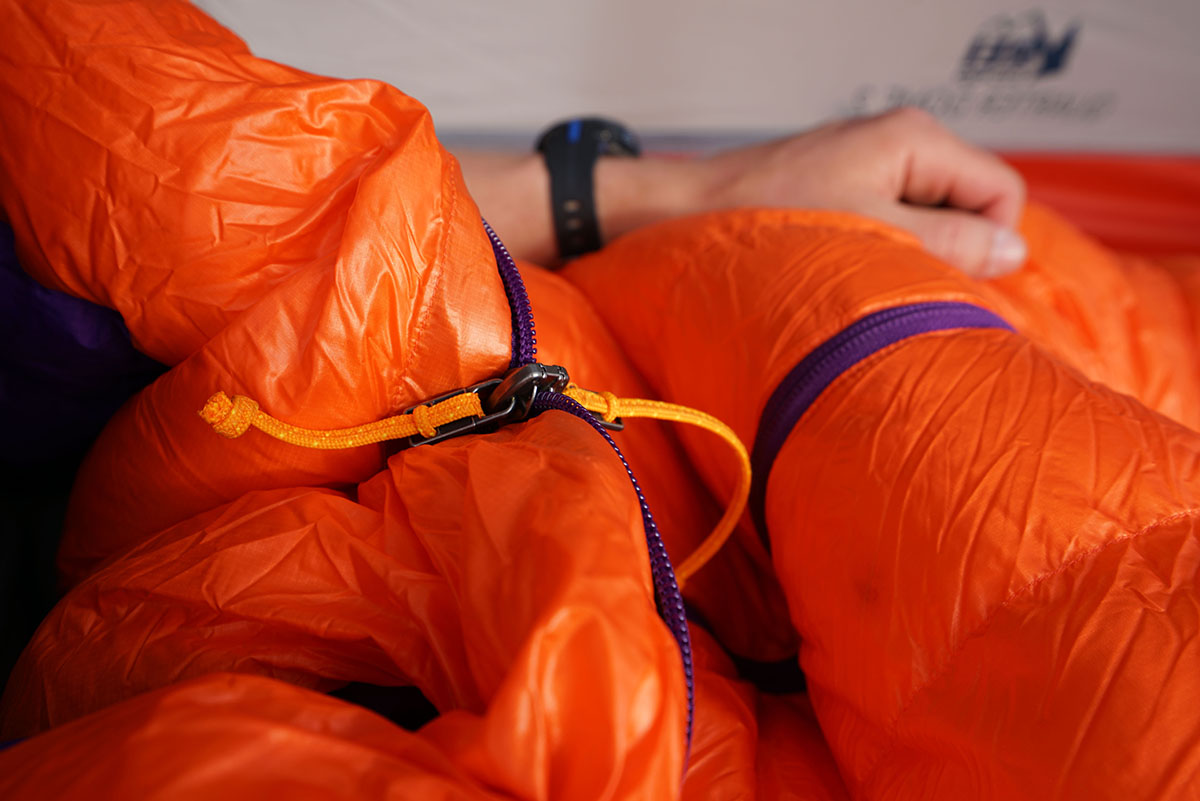

| Sleeping Bag | Price | Temp | Weight | Fill | Fill Weight | Shell |
|---|---|---|---|---|---|---|
| Patagonia 850 Down Sleeping Bag | $499 | 19°F (EN) | 2 lb. 0.2 oz. | 850-fill down | 19.7 oz. | 15D |
| Feathered Friends Hummingbird UL 20 | $509 | 20°F | 1 lb. 8 oz. | 950-fill down | 14 oz. | 10D |
| Feathered Friends Swallow YF 20 | $449 | 20°F | 1 lb. 12.7 oz. | 900-fill down | 16.8 oz. | 20D |
| Western Mountaineering UltraLite | $525 | 20°F | 1 lb. 13 oz. | 850-fill down | 16 oz. | 12D |
| REI Co-op Magma 15 | $369 | 16°F (EN) | 1 lb. 12.2 oz. | 850-fill down | 15.9 oz. | 15D |
Patagonia created a solid sleeping bag with the 850 Down, but there is no shortage of competition. Seattle-based Feathered Friends specializes in premium down products, and their Hummingbird UL 20 is one of our favorite designs on the market. Compared to the Patagonia, you get higher-quality 950-fill down (although less of it at 14 ounces of fill weight) in a lightweight 1-pound-8-ounce package (8.2 ounces less than the Patagonia). And despite the lack of EN/ISO rating, we’ve found that Feathered Friends’ bags often run warmer than their temperature ratings suggest. At $509, the Hummingbird is $10 pricier than the Patagonia, but that’s a negligible price penalty for an exceptionally well-rounded design.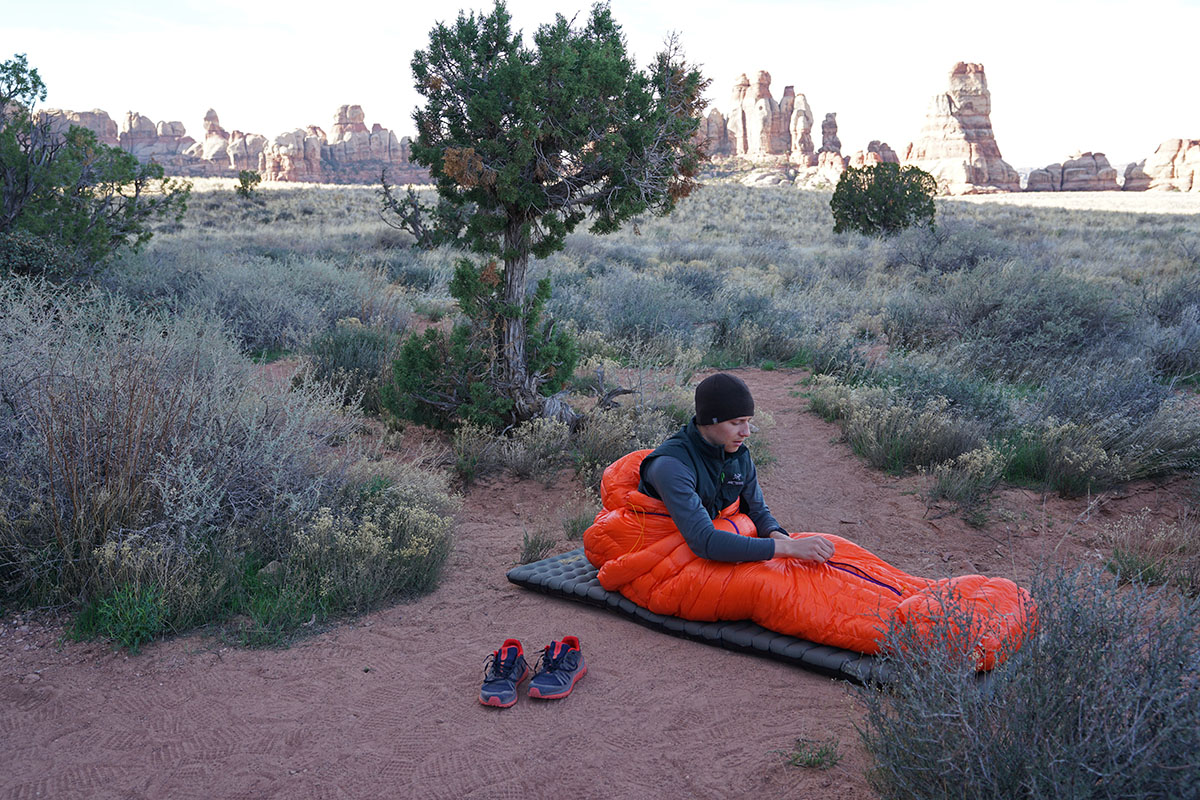
In addition to the Hummingbird, another Feathered Friends option to consider is the Swallow YF 20. At $449, the Swallow undercuts the Patagonia by a considerable $50 but is more durable with a 20-denier shell, uses higher-quality 900-fill down, and is comparably warm with 16.8 ounces of fill and a 20-degree temperature rating (remember, Feathered Friends often is conservative with their ratings). Both are excellent 20ish-degree backpacking bags, and we do love the Patagonia’s plush hood. That said, we give the overall nod to the cheaper Feathered Friends.
The Western Mountaineering UltraLite is another top-notch backpacking bag at a similar price point as the Patagonia ($525). The UltraLite uses the same 850-fill power but has less fill weight at 16 ounces vs. 19.7 ounces (we suspect that some of that is located in Patagonia’s luxurious hood). However, we still favor Western Mountaineering based on experience: the company has made high-end backpacking bags for decades with glowing reviews pretty much across the board. Patagonia just isn’t a sleeping bag specialist, the center zipper wasn’t a game-changer for us, and there were a couple of issues with the first run of this bag.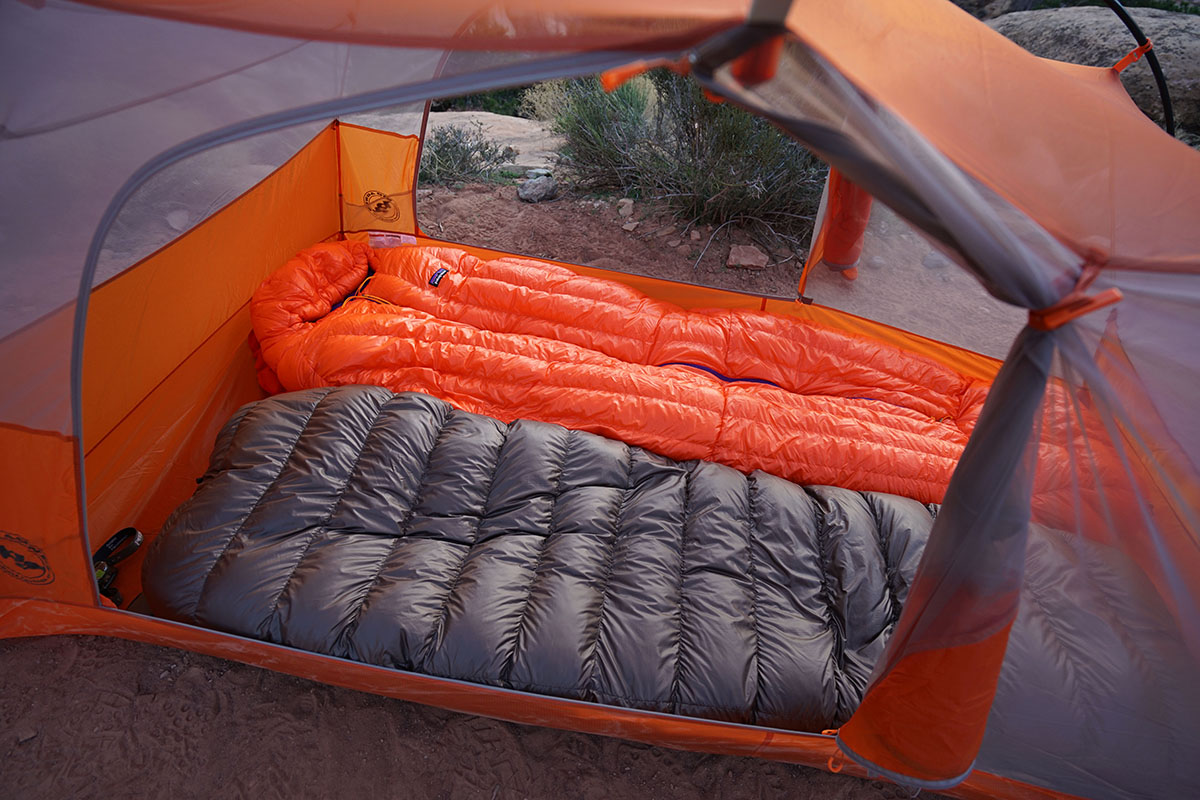
Last but not least, for those looking to save, it’s hard to beat REI Co-op’s Magma series. The Magma 15 gives the Patagonia a real run for its money: it’s warm with 15.9 ounces of water-resistant 850-fill down (3.8 ounces less than the Patagonia), is 4 ounces lighter at 1 pound 12.2 ounces, and is EN-rated down to 16 degrees (the Patagonia has a 19-degree Lower Limit rating). In the end, both are premium and well-made bags from reputable brands, but the clincher for us is price: at $369, the REI undercuts the Patagonia by a significant $130 without any major sacrifices in performance. You can’t go wrong with either for 3-season adventures, but the Magma currently is our top-rated backpacking sleeping bag for 2019 and for good reason.
Editor’s note: We usually provide a live price comparison table below our outdoor gear reviews, but the 850 Down Sleeping Bag is sold exclusively by Patagonia. You can see the 850 Down page here and support us in the process. Thanks!